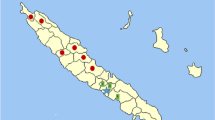Abstract
Burkholderia pseudomallei is the environmental bacterium that causes the serious disease melioidosis. Recently, a high prevalence of viable B. pseudomallei was reported from natural groundwater seeps around Castle Hill, a clinical focus of melioidosis in Townsville, Australia. This study sought to expand previous findings to determine the extent of B. pseudomallei in more diverse natural groundwater seeps in northern Queensland to ascertain if the presence of the organism in groundwater on Castle Hill was an isolated occurrence. Analysis of water samples (n = 26) obtained from natural groundwater seeps following an intensive rainfall event in the Townsville region determined the presence of B. pseudomallei DNA in duplicates of 18 samples (69.2 % [95 % CI, 51.5 to 87.0]). From 26 water samples, a single isolate of B. pseudomallei was recovered despite plating of both pre-enriched samples and original water samples onto selective media, indicating that the sensitivity of these molecular techniques far exceeds culture-based methods. Furthermore, the identification of new environments endemic for melioidosis may be more effectively determined by analysing surface groundwater seeps than by the analysis of random soil samples. This study suggests that a higher incidence of melioidosis following monsoonal rains may be partially the result of exposure to groundwater sources carrying B. pseudomallei, and that modifications to public health messages in endemic regions may be warranted. Moreover, these findings have implications for predictive models of melioidosis, effective models requiring consideration of topographical and surface hydrological data.

Similar content being viewed by others
References
Ashdown LR (1979) An improved screening technique for isolation of Pseudomonas pseudomallei from clinical specimens. Pathology 11:293–297
Ashdown LR, Clarke SG (1992) Evaluation of culture techniques for isolation of Pseudomonas pseudomallei from soil. Appl Environ Microbiol 58:4011–4015
Baker A, Mayo M, Owens L, Burgess G, Norton R, McBride WJ, Currie BJ, Warner J (2013) Biogeography of Burkholderia pseudomallei in the Torres Strait Islands of Northern Australia. J Clin Microbiol 51:2520–2525
Baker A, Tahani D, Gardiner C, Bristow KL, Greenhill AR, Warner J (2011) Groundwater seeps facilitate exposure to Burkholderia pseudomallei. Appl Environ Microbiol 77:7243–7246
Chantratita N, Wuthiekanun V, Boonbumrung K, Tiyawisutsri R, Vesaratchavest M, Limmathurotsakul D, Chierakul W, Wongratanacheewin S, Pukritiyakamee S, White NJ, Day NP, Peacock SJ (2007) Biological relevance of colony morphology and phenotypic switching by Burkholderia pseudomallei. J Bacteriol 189:807–817
Corkeron M, Norton R, Nelson PN (2010) Spatial analysis of melioidosis distribution in the Townsville region of North Queensland. Epidemiol Infect 138:1345–1352
Currie BJ, Dale F, Anstey NM, Huffam SE, Hassell M, Davis J, Price R, Lum GD, Stephens DP, Jacups SP (2002) Melioidosis—a dry wet season results in fewer Top End cases. N Territ Dis Control Bull 9:1–2
Currie BJ, Fisher DA, Howard DM, Burrow JN, Lo D, Selva-Nayagam S, Anstey NM, Huffam SE, Snelling PL, Marks PJ, Stephens DP, Lum GD, Jacups SP, Krause VL (2000) Endemic melioidosis in tropical northern Australia: a 10-year prospective study and review of the literature. Clin Infect Dis 31:981–986
Currie BJ, Jacups SP, Cheng AC, Fisher DA, Anstey NM, Huffam SE, Krause VL (2004) Melioidosis epidemiology and risk factors from a prospective whole-population study in northern Australia. Trop Med Int Health 9:1167–1174
Draper AD, Mayo M, Harrington G, Karp D, Yinfoo D, Ward L, Haslem A, Currie BJ, Kaestli M (2010) Association of the melioidosis agent Burkholderia pseudomallei with water parameters in rural water supplies in northern Australia. Appl Environ Microbiol 76:5305–5307
Faa AG, Holt PJ (2002) Melioidosis in the Torres Strait islands of far North Queensland. Commun Dis Intell 26:279–283
Kaestli M, Mayo M, Harrington G, Ward L, Watt F, Hill JV, Cheng AC, Currie BJ (2009) Landscape changes influence the occurrence of the melioidosis bacterium Burkholderia pseudomallei in soil in Northern Australia. PLoS Negl Trop Dis 3:e364
Limmathurotsakul D, Dance DA, Wuthiekanun V, Kaestli M, Mayo M, Warner J, Wagner DM, Tuanyok A, Wertheim H, Yoke Cheng T, Mukhopadhyay C, Puthucheary S, Day NP, Steinmetz I, Currie BJ, Peacock SJ (2013) Systematic review and consensus guidelines for environmental sampling of Burkholderia pseudomallei. PLoS Negl Trop Dis 7:e2105
Marshall K, Shakya S, Greenhill AR, Padilla G, Baker A, Warner JM (2010) Antibiosis of Burkholderia ubonensis againist Burkholderia pseudomallei, the causative agent for melioidosis. Southeast Asian J Trop Med Public Health 41:904–912
Novak RT, Glass MB, Gee JE, Gal D, Mayo MJ, Currie BJ, Wilkins PP (2006) Development and evaluation of a real-time PCR assay targeting the type III secretion system of Burkholderia pseudomallei. J Clin Microbiol 44:85–90
Palasatien S, Lertsirivorakul R, Royros P, Wongratanacheewin S, Sermswan RW (2008) Soil physicochemical properties related to the presence of Burkholderia pseudomallei. Trans R Soc Trop Med Hyg 102(Suppl 1):S5–S9
Sagripanti JL, Levy A, Robertson J, Merritt A, Inglis TJ (2009) Inactivation of virulent Burkholderia pseudomallei by sunlight. Photochem Photobiol 85:978–986
Thomas AD, Forbes-Faulkner J, Parker M (1979) Isolation of Pseudomonas pseudomallei from clay layers at defined depths. Am J Epidemiol 110:515–521
Yordpratum U, Tattawasart U, Wongratanacheewin S, Sermswan RW (2011) Novel lytic bacteriophages from soil that lyse Burkholderia pseudomallei. FEMS Microbiol Lett 314:81–88
Acknowledgements
We acknowledge the assistance of Janine Chang Fung Martel at James Cook University for the assistance during sample collection.
Author information
Authors and Affiliations
Corresponding author
Rights and permissions
About this article
Cite this article
Baker, A.L., Warner, J.M. Burkholderia pseudomallei is frequently detected in groundwater that discharges to major watercourses in northern Australia. Folia Microbiol 61, 301–305 (2016). https://doi.org/10.1007/s12223-015-0438-3
Received:
Accepted:
Published:
Issue Date:
DOI: https://doi.org/10.1007/s12223-015-0438-3




